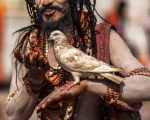Undoubtedly one of the largest congregations of religious pilgrims, the Kumbh Mela has captured the imagination of people across the world. Included in UNESCO’s list of the 'Intangible Cultural Heritage of Humanity’, the festival has many myths and lore associated both with its origins and the many rituals performed during the 55 days that it is held. While it is popularly believed to find mention in the Vedas and Puranas, many scholars have argued that this scriptural reference is possibly more recent and was made to give it antiquity. Irrespective of the differences in opinion and scholarship, there is no denying the socio-cultural significance of the Kumbh Mela for Hindus and Indians.
The Kumbh Mela is a tremendous display of faith—a festival that attracts millions of pilgrims from around the world. It is popularly believed that the Mela, or fair, has roots in the Puranas and the Vedas, and that taking a dip in the holy water during the festival grants one moksha, escape from the cycle of birth and death. However, over time, many scholars have pointed out that there is no mention of the Kumbh Mela in the ancient texts and have suggested that the association with the canons was more recent, in order to add to its antiquity. (Also read: Kumbh Mela: Do Our Vedic Texts Mention this Unique Pilgrimage?)
Held at regular intervals of six, 12 and 144 years, across the four cities of Prayagraj (erstwhile Allahabad), Haridwar, Ujjain and Nashik, the festival is regarded as one of the world’s largest pilgrimages. Over the centuries, the fair has also been recorded by world travellers such as Xuanzang (Hiuen Tsang) and Mark Twain, and documented widely under the British colonial rule. The shahi snans (ritualistic baths) and mass congregation of ascetics who have otherwise renounced the world are key elements of the festival.
Interestingly, not only is the Kumbh Mela significant for Hindus and those on a spiritual path, but thanks to the Indian film industry, it was also a key part of pop culture rubric through the 1970s and 1980s. Those who are familiar with the movies from that era would easily recall the line ‘Kumbh ke mele mein bhichhde hue…’, referring to siblings or family who have been separated at the Kumbh Mela, only to reconnect years later. This wasn’t far from the truth as a fair number of people would be registered missing at the fair each time. However, in recent years, the congregation has witnessed various administrative and technological changes that led to not a single missing person at the Kumbh Mela in 2015 in Nashik. The one in 2013, at Prayagraj, reportedly had 2,25,000 missing people.
While the Mela is widely reported each time, the 2019 edition’s headlines had much to do with the controversial name change of the city of Allahabad to Prayagraj just a fortnight before it was due to begin on January 4. The proposition for this change in name had been in place for more than two decades.
Irrespective of its historicity, the Kumbh Mela holds an important position in the Indian cultural landscape, and the charm and grandeur of the majestic festival has remained unmatched. This photo essay explores the magnificence of the Kumbh Mela, while shedding some light on its history and the narratives that revolve around the festival.
(The photographs were submitted as part of the #KumbhStories campaign run by Sahapedia during the Ardh Kumbh at Prayagraj, January to March 2019)
Bibliography
Singh, Pratyush. ‘The Role of Kumbh Mela in the Cultural Developments of Allahabad A Study in Cultural Geography’. PhD thesis, Department of Geography, University of Allahabad, 2013.
MacLean, Kama. ‘Making the Colonial State Work for You: The Modern Beginnings of the Ancient Kumbh Mela in Allahabad,’ The Journal of Asian Studies 62, no. 3 (2003): 886.
Singh, Pratyush. ‘The Role of Kumbh Mela in the Cultural Developments of Allahabad A Study in Cultural Geography’. PhD thesis, Department of Geography, University of Allahabad, 2013.
Lochtefeld, James G. ‘Getting in Line: The Kumbh Mela Festival Processions.’ In South Asian Religions on Display, edited by Knut A. Jacobsen. New York: Routledge, 2008.
Maclean, Kama. Pilgrimage and Power: The Kumbh Mela in Allahabad 1765-1954. USA: Oxford University Press, 2008.
















